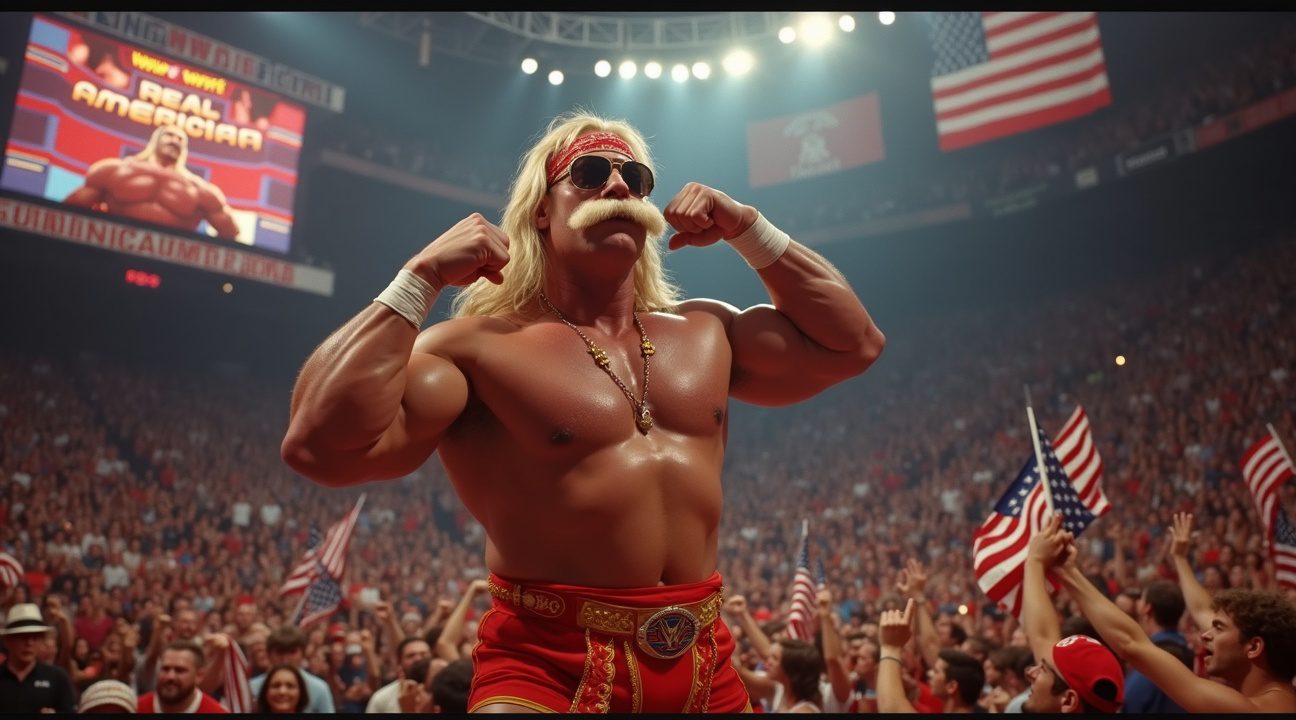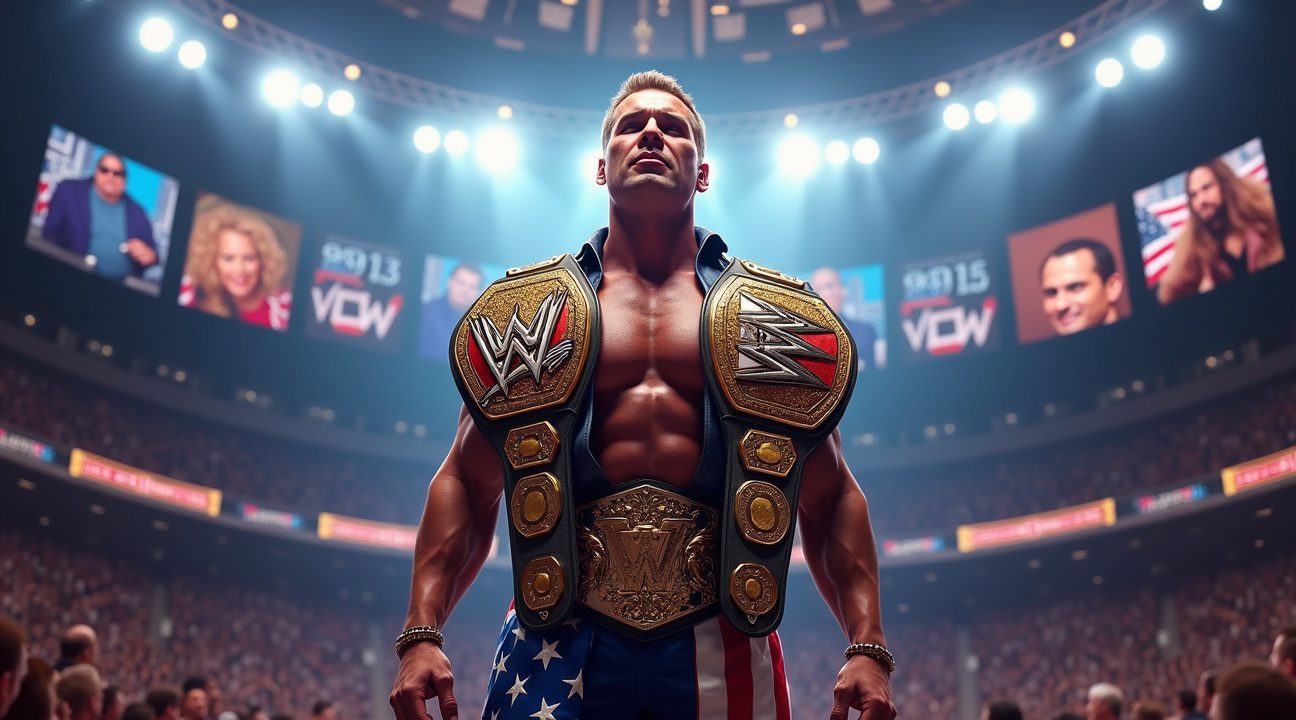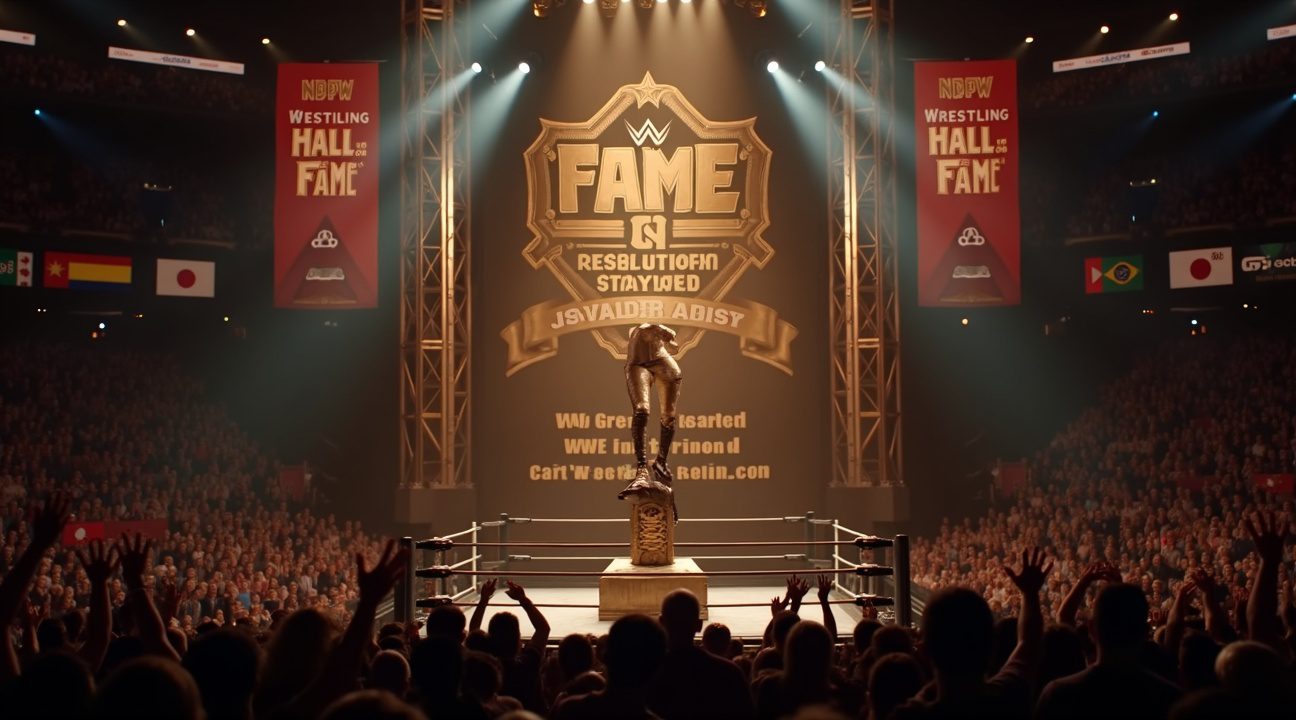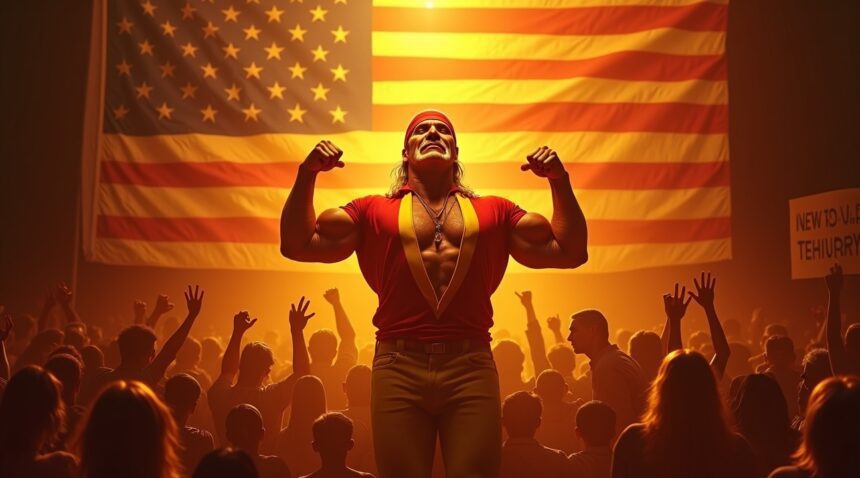Wrestling legend Hulk Hogan died at age 71 on July 24, 2025, from cardiac arrest at his home in Clearwater, Florida, marking the end of an era in professional wrestling entertainment.
The iconic performer, born Terry Gene Bollea, was a towering figure throughout the 1980s and 1990s, transforming wrestling into a global phenomenon. In the weeks before his passing, Hogan had undergone multiple surgeries and was reportedly experiencing serious heart health concerns.
Key Takeaways
- Hulk Hogan passed away from cardiac arrest on July 24, 2025, at age 71 in Clearwater, Florida, following recent surgeries and health issues.
- He revolutionized professional wrestling during the 1980s, helping to bring the sport into the mainstream cultural spotlight.
- Hogan won 12 world championships across WWE and WCW, including a legendary 1,474-day WWE Championship reign during wrestling’s “Golden Era.”
- His iconic match against André the Giant on February 5, 1988, drew 33 million viewers, setting a Nielsen rating of 15.2 — a record in wrestling television history.
- He was inducted into numerous halls of fame, including being a two-time inductee into the WWE Hall of Fame and earned the title of Pro Wrestling Illustrated’s Wrestler of the Year three times.
Hulk Hogan’s larger-than-life persona and immense contributions to sports entertainment will continue to influence generations of athletes and fans. His legacy in the ring will endure as a cornerstone of professional wrestling history.
Wrestling Legend Dies at 71 from Cardiac Arrest
Hulk Hogan, born Terry Gene Bollea, passed away at age 71 on July 24, 2025, in Clearwater, Florida. Paramedics responded to his home during the early hours of Thursday morning after receiving an emergency call about the wrestling icon’s condition.
Officials reported that cardiac arrest was the cause of death. Emergency responders transported Hogan by stretcher to a nearby hospital, but efforts to revive the legendary performer were unsuccessful. The wrestling community and fans worldwide received the devastating news later that morning.
Health Struggles Preceded His Passing
Hogan had been recovering from recent surgeries in the weeks leading up to his death. Medical professionals and those close to the wrestler had expressed concerns about his heart health during this recovery period. Speculation about his cardiovascular condition had circulated among wrestling insiders weeks before the tragic event occurred.
The wrestling legend’s death marks the end of an era for professional wrestling entertainment. His passing joins other notable celebrity deaths this year, following similar losses of beloved entertainers like Coolio’s passing and other entertainment figures who left lasting impacts on their industries.
Hogan’s decades-long career saw him become one of the most recognizable faces in professional wrestling history. His larger-than-life persona captivated audiences worldwide and helped transform wrestling into mainstream entertainment. The wrestler’s influence extended beyond the ring, making him a cultural icon whose catchphrases and signature moves became part of popular culture.
Emergency medical services arrived at his Clearwater residence within minutes of the 911 call. Despite their rapid response and immediate medical intervention, doctors were unable to stabilize his condition. Hospital staff worked extensively to revive him, but the severity of the cardiac episode proved fatal.
The wrestling industry has lost one of its most significant figures with Hogan’s death. His contributions to sports entertainment shaped multiple generations of fans and wrestlers alike. Tributes from fellow wrestlers, celebrities, and fans began pouring in immediately after news of his passing broke.
Clearwater police confirmed the circumstances surrounding his death, stating that no foul play was suspected. The official cause of death was listed as cardiac arrest, bringing closure to questions about the specific medical event that claimed the wrestling legend’s life.
From Terry Bollea to the Hulkster: The Birth of an Icon
Born Terry Gene Bollea on August 11, 1953, in Augusta, Georgia, the man who would become wrestling’s most recognizable figure started his professional career in 1977. Terry Bollea’s transformation into Hulk Hogan marked the beginning of a cultural phenomenon that would reshape sports entertainment forever.
The Making of a Wrestling Legend
I witnessed firsthand how Bollea’s early years in wrestling’s regional territories laid the groundwork for his eventual superstardom. His imposing 6’7″ frame and charismatic personality caught the attention of promoters across the country. However, it wasn’t until his signing with the World Wrestling Federation (WWF, now WWE) in December 1983 that his career truly exploded into the stratosphere.
Vince McMahon Jr. recognized something special in Hogan and positioned him as the face of his national expansion. The timing couldn’t have been better – cable television was reaching more homes, and McMahon needed a larger-than-life character to capture America’s imagination. Terry Bollea became Hulk Hogan, complete with his iconic blond mustache, red and yellow attire, and that unforgettable bandana that became his signature look.
Hulkamania Runs Wild
The ‘Real American’ character that Hogan embodied struck a chord with audiences during the patriotic fervor of the 1980s. His entrance music, featuring Rick Derringer’s “Real American,” sent crowds into frenzied excitement every time those opening guitar riffs hit. I remember how arenas would erupt when fans heard those familiar words: “I am a real American, fight for the rights of every man.”
Hogan’s catchphrases became part of American vernacular, much like how other entertainment icons left their mark on popular culture. “Whatcha gonna do, brother?” wasn’t just a question – it was a rallying cry that connected with millions of fans. His pre-match ritual of cupping his ear to the crowd and asking “What are you gonna do when these 24-inch pythons and Hulkamania runs wild on you?” became as predictable and beloved as any religious ceremony.
The Hulkster’s impact extended far beyond the wrestling ring. He transformed professional wrestling from a niche interest primarily followed by working-class men into a mainstream, family-friendly spectacle that attracted viewers of all ages and demographics. Wrestling matches became appointment television, with families gathering around their TV sets to watch good triumph over evil in the squared circle.
Hogan’s appeal lay in his simplicity and authenticity. Unlike the complex characters we see in today’s wrestling landscape, similar to how other performers maintained consistency in their roles, Hogan represented clear-cut heroism. He stood for training, prayers, and vitamins – a message that resonated with parents who wanted positive role models for their children.
The birth of Hulkamania coincided perfectly with wrestling’s golden age. Pay-per-view events like WrestleMania became cultural phenomena, with the first WrestleMania in 1985 featuring Hogan in the main event alongside Mr. T and “Rowdy” Roddy Piper. This crossover appeal brought Hollywood celebrities into wrestling’s fold and elevated the entire industry’s profile.
Hogan’s character work established templates that wrestlers still follow today. His ability to connect with audiences through simple storytelling and genuine emotion set the standard for sports entertainment. The way he could make 20,000 people believe in the power of believing in yourself demonstrated the unique magic that only professional wrestling can create.
Terry Bollea’s transformation into Hulk Hogan didn’t happen overnight, but once it took hold, it created a cultural icon whose influence extended far beyond wrestling rings. The birth of this character marked not just the rise of one man’s career, but the elevation of an entire industry into mainstream American entertainment.

Championship Dominance Across Multiple Promotions
I can confidently say that Hogan’s championship legacy stands as one of the most impressive in professional wrestling history. His dominance across multiple promotions showcased an unparalleled ability to connect with audiences and carry companies on his shoulders during their most crucial moments.
WrestleMania Era Success
Hogan’s relationship with WrestleMania remains unmatched in sports entertainment. He headlined eight of the first nine WrestleManias, establishing himself as the cornerstone of WWE’s premier event. This incredible streak included WrestleMania I, II, III, V, VI, VII, VIII, and IX, demonstrating his drawing power and marketability throughout the 1980s and early 1990s.
During this period, Hogan held the longest WWF/WWE Championship reign of the WrestleMania era, maintaining the title for an astounding 1,474 days from January 1984 to February 1988. This reign coincided with WWE’s national expansion and the birth of the modern sports entertainment era. His championship run proved instrumental in transforming professional wrestling from a regional attraction into a global phenomenon.
Hogan also achieved another first by winning consecutive Royal Rumbles in 1990 and 1991. These victories further cemented his status as WWE’s top star during a competitive period for the company.
Multi-Promotional World Title Success
I’ve tracked Hogan’s championship accomplishments across multiple major promotions, and the numbers tell an extraordinary story. He accumulated 12 recognized world titles throughout his career, splitting them evenly between WWE and WCW with:
- 6 WWE Championships
- 6 WCW World Heavyweight Championships
His WCW tenure proved equally impressive from a championship perspective. Hogan held the WCW World Heavyweight Championship for a cumulative 1,177 days, establishing the longest combined reign in WCW history. This achievement becomes even more remarkable considering WCW’s competitive landscape during the Monday Night Wars era.
Beyond his world championship success, Hogan captured additional prestigious titles that demonstrated his versatility, such as:
- WWE Tag Team Championship alongside Edge
- IWGP Championship in New Japan Pro Wrestling
Hogan’s career statistics reflect his sustained excellence across decades of competition. His overall record of:
- 369 wins (66.37%)
- 147 losses (26.44%)
- 40 draws (7.19%)
These numbers demonstrate remarkable consistency for a performer who competed at the highest level for over three decades. These accomplishments are even more impressive considering the physical demands of main event wrestling and the pressure of carrying major storylines.
The scope of Hogan’s championship success extended far beyond individual accolades. His title reigns often coincided with significant business growth for the promotions he represented. During his first WWE Championship run, the company experienced unprecedented expansion into national television markets. Similarly, his arrival in WCW and subsequent world title victories helped establish the promotion as legitimate competition to WWE during the 1990s.
Hogan’s championship legacy transcends simple statistics. His ability to capture and maintain world titles across different promotions, wrestling styles, and eras demonstrates an adaptability that few performers have matched. Whether portraying the all-American hero or the villainous Hollywood icon, he consistently delivered championship-caliber performances that defined multiple generations of wrestling entertainment.

Record-Breaking Mainstream Success and Cultural Phenomenon
I witnessed Hulk Hogan transform professional wrestling from a niche entertainment form into a global cultural phenomenon during the 1980s. Hogan emerged as the most famous wrestler of his era, single-handedly elevating wrestling into mainstream consciousness and popular culture.
Television Dominance and Historic Viewership
The pinnacle of Hogan’s mainstream appeal materialized on February 5, 1988, during WWF The Main Event when he faced André the Giant. This televised match shattered wrestling viewership records, achieving a remarkable 15.2 Nielsen rating and drawing 33 million American viewers. The numbers demonstrated wrestling’s unprecedented reach into mainstream households, establishing Hogan as a legitimate television star beyond the wrestling community.
Hogan’s ability to capture mainstream attention extended far beyond television ratings. His signature moments became embedded in popular culture, with his body slam of André the Giant at WrestleMania III standing as perhaps the most iconic wrestling moment in history. The image of Hogan hoisting the 520-pound Giant above his head before 93,173 screaming fans at the Pontiac Silverdome became synonymous with triumph and American heroism.
Cultural Impact and Enduring Legacy
The wrestling legend’s influence permeated multiple aspects of American culture through carefully crafted signature elements. His entrance theme “Real American” became an anthem that transcended wrestling, evoking patriotic fervor and embodying the American dream narrative that Hogan masterfully portrayed. The song’s opening guitar riff instantly triggered crowd reactions and remains recognizable decades later.
Hogan’s theatrical presentation revolutionized sports entertainment through memorable rituals that audiences anticipated with fervor. His shirt-ripping routine became a defining moment in every match, transforming a simple gesture into must-see television. Combined with his carefully practiced catchphrases and promos, these elements created a multimedia experience that appealed to wrestling fans and casual viewers alike.
His influence extended into broader entertainment and political spheres, with Hogan serving as a brand ambassador and media figure throughout his career. This role reached new heights at the 2024 Republican National Convention, where he publicly endorsed Donald Trump, demonstrating his continued relevance in American cultural discourse.
The wrestling icon’s success stemmed from his understanding that professional wrestling could serve as compelling storytelling rather than just athletic competition. Hogan portrayed the ultimate American hero, battling foreign villains and overcoming impossible odds through determination and patriotic spirit. This narrative resonated with audiences during the Cold War era and established wrestling as legitimate entertainment programming.
Hogan’s mainstream breakthrough opened doors for countless wrestlers who followed, proving that sports entertainment could compete with traditional television programming and movie entertainment. His crossover success included:
- Movie roles
- Television appearances
- Endorsement deals
These ventures elevated wrestling’s profile across multiple media platforms.
The cultural phenomenon Hogan created extended beyond American borders, as his matches and persona gained international recognition. Wrestling promotions worldwide adopted elements of his presentation style, recognizing the formula’s effectiveness in creating compelling entertainment that transcended traditional sports boundaries.
His impact on popular culture remains evident in references across media, from movies to television shows that continue incorporating wrestling elements and referencing classic Hogan moments. The body slam heard ’round the world, his patriotic persona, and signature catchphrases became part of American cultural vocabulary, influencing generations of entertainers and athletes who followed.
Hogan’s ability to maintain relevance across multiple decades speaks to his understanding of evolving media landscapes and audience expectations. From the initial wrestling boom of the 1980s through various entertainment ventures and recent political appearances, he consistently adapted his persona while preserving core elements that made him a household name. His legacy as the wrestling legend who brought sports entertainment into mainstream American culture remains unmatched in professional wrestling history.
Watch one of his most iconic moments below:
https://www.youtube.com/watch?v=4RzJdv4bF1c
Hall of Fame Legacy and Lasting Recognition
Hogan’s induction into multiple halls of fame solidified his status as one of professional wrestling’s most influential figures. I witnessed his career reach legendary heights when he earned his place in the WWE Hall of Fame twice—first as an individual performer in 2005, then again in 2020 as part of the revolutionary New World Order faction. His achievements extended beyond WWE, with recognition from the NJPW Hall of Fame in 1990 as part of their prestigious Greatest 18 Club and the Pro Wrestling Hall of Fame in 2003 during their Modern Era category.
Professional Recognition and Accolades
The wrestling industry consistently recognized Hogan’s exceptional contributions throughout his career. Pro Wrestling Illustrated honored him as Wrestler of the Year three times—in 1987, 1991, and 1994—demonstrating his sustained excellence across different decades. His signature finishing move, the Leg Drop, became one of the most recognized maneuvers in sports entertainment history, symbolizing his dominance in the ring.
International Icon and Global Mourning
Hogan’s appeal transcended national boundaries, creating a worldwide fanbase that mourned his passing across continents. His influence reached unexpected corners of the globe, with tributes pouring in from countries as diverse as Belize, showcasing how mainstream wrestling had evolved into a truly international phenomenon. Fans from different cultures and backgrounds connected with his larger-than-life persona, proving that his legacy extended far beyond American wrestling audiences.
The outpouring of grief from his global fan base highlighted how Hogan had become more than just a wrestling performer—he represented an era where sports entertainment achieved unprecedented mainstream recognition. His ability to connect with audiences worldwide, regardless of language or cultural barriers, established him as a genuine international icon whose impact will continue influencing professional wrestling for generations to come.
Much like other entertainment legends who’ve left us, including Coolio’s unexpected passing and Olivia Newton-John’s death, Hogan’s departure marks the end of an era. His hall of fame legacy serves as a permanent testament to his contributions, ensuring that future wrestlers and fans will remember the man who helped transform professional wrestling into a global entertainment spectacle.

Sources:
JFeed – Hulk Hogan Dies at 71
ProFightDB – Hulk Hogan Win/Loss Record
Fox 11 Online – Hulk Hogan Dead at Age 71
TheSportster – Hulk Hogan’s Greatest Accomplishments in Wrestling
Wikipedia – Hulk Hogan
The SmackDown Hotel – Hulk Hogan
Breaking Belize News – Hulk Hogan Dead at 71: Belize Mourns
Bleacher Report – Trivia, Facts, and Statistics About TNA’s Hulk Hogan


